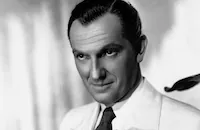Lady of the Tropics

Brief Synopsis
Cast & Crew
Jack Conway
Robert Taylor
Hedy Lamarr
Joseph Schildkraut
Gloria Franklin
Ernest Cossart
Film Details
Technical Specs

Synopsis
When destitute playboy Bill Carey arrives in Saigon on a yacht owned by Alfred Z. Harrison, an American millionaire whose daughter Dolly he plans to marry, he meets exotic half-caste Manon De Vargnes, falls violently in love and jumps ship. Manon, tortured by her status as an outcast, and denied a passport because of her mixed birth, dreams of going to Paris, and at first sees Bill as her ticket out of Saigon. She soon falls in love with the kind Bill, however, and agrees to give up a planned marriage with a rich Asian nobleman. Their romance incurs the wrath of Peter Delaroch, another wealthy man, who is also a half-caste who desires Manon for himself. His enormous political power insures that he gets what he wants, and to avoid Delaroch's advances, Manon promises to marry him, even though she has already accepted Bill's proposal. Father Antione warns Bill about becoming involved with an inscrutable half-caste, but Bill ignores his warnings and marries Manon anyway. After her wedding, Pierre prevents Manon from leaving the country by ordering the governor to refuse her a passport. As Bill's his funds are exhausted, the destitute Manon arranges a job for her husband at one of Delaroch's rubber companies in exchange for her honor. On leave from the rubber plantation, Bill learns the terrible price that his wife has paid when he receives an anonymous item from a society column which mentions that Manon and Delaroch had gone to see the opera Manon Lescont together. At first Bill thinks that the incident was innocent, but when Manon tells him that she has finally gotten a passport to leave Saigon, and he later finds Delaroch's cigar case among Manon's things, he becomes enraged and determines to kill their tormentor. Manon deprives Bill of revenge however, by shooting Delaroch herself, then returns to her hotel room and turns the gun on herself. When Bill discovers that Manon has killed Delaroch, he rushes home and begs her to leave the country with him to avoid her arrest, but it is too late to save her. When she realizes that Bill still loves her and has forgiven her, she is able to die happily in his arms, holding her passport in her hand.

Director

Jack Conway
Cast

Robert Taylor

Hedy Lamarr

Joseph Schildkraut
Gloria Franklin

Ernest Cossart
Mary Taylor
Charles Trowbridge
Frederick Worlock
Paul Porcasi
Margaret Padula

Cecil Cunningham

Natalie Moorhead
Willie Fung

Frank Puglia

Charles Halton

Richard Loo
Crew
Adrian
Foster Carling
Harriet Cruise
Leslie Fenton
George Folsey
Dave Friedman
Cedric Gibbons
Paul Groesse
Ben Hecht
James Mckay
Phil Ohman
Douglas Shearer
Al Shenberg
Valles
Elmo Veron
Louis Vincenot
Franz Waxman
Edwin B. Willis
William Von Wymetal
Sam Zimbalist

Videos
Trailer
Hosted Intro
Film Details
Technical Specs

Award Nominations
Best Cinematography
Articles
Lady of the Tropics
Not that she had much of an idea of what to do with herself. In a career marked by more bad script choices than good ones-- she turned down Gaslight (1940) and Casablanca (1942) -- she remained, metaphorically, at sea. Her American debut, as the object of Casbah-minded Charles Boyer in Algiers (1938), was a smash. Lamarr's Hollywood honeymoon ended one film later, with Lady of the Tropics (1939). Far from seeming awash in the sultriness promised by its title, it's a half-hearted manufacture, tepid in every way, except its costumes, lighting and ability of cinematographer George Folsey to create on a Culver City backlot the movies' idea of between-the-wars exoticism in what was then known as French Indochina. Essentially, the story is a barely warmed over version of the durable never-the-twain-shall-meet Manon Lescaut, which has been jerking tears from the eyes of readers, opera-goers and filmgoers ever since the Abbe Prevost published his novel in 1731.
In this version, a Ben Hecht script that seems (like so much of the rest of the film) mailed in, Lamarr plays Manon deVargnes, a so-called half-caste whose father was French, whose mother was native, and whose dream of living in Paris as a Frenchwoman is doomed to failure by racism. The best she can hope for is a double-standard liaison with a powerful French businessman, in charge of looting the country's rubber resources on behalf of France. He's happy to sleep with her, but inviting her to tea with his respectable friends, much less marrying her, is out of the question, even a charade of a local marriage, to be annulled by his return to France. Enter Robert Taylor, stalwart member of the MGM rep company, as an American playboy, traveling on the yacht of his girlfriend's rich family. Taylor, a newly established MGM star, seems to be recycling bits of his redeemed playboy from Magnificent Obsession (1935) and his rueful aristocratic lover watching Garbo's Camille (1936) expire. He and Lamarr had to summon more than the usual amounts of stardust. Off-camera Taylor was romancing Barbara Stanwyck, his co-star in His Brother's Wife (1936), and took time off during the shoot to marry her.
One look at Lamarr's demure Manon here, however, and Taylor's cocky rake turns his back on riches, jumps ship, and marries her, assuming with misplaced American optimism that he'll take her stateside, where they'll live happily ever after. But no. The influential Frenchman can block her passport, and does. As the playboy's money runs out, and his friends tire of his increasingly desperate cablegrams, she contrives to get him a job upriver on a rubber plantation. He hasn't a clue that it's the rich Frenchman pulling strings. She, meanwhile, never gets as far as sleeping with the string-puller. But she does attend the opera (Manon Lescaut, mais naturellement!) with her well-heeled benefactor as arm candy on opening night. It would help if sneering or nastiness came a bit more naturally to the noble-profiled, noble-figured Schildkraut. But he seems ill at ease, bowing stiffly from the waist a lot, saying "Thank you" a lot. His veneer of good manners never seems nasty, malicious or gloating. He seems more like a nervous headwaiter.
The discovery here is Gloria Franklin, in the subsidiary part of Manon's sister. As a nightclub singer with a string of casual marriages behind her, she projects a genuine sweetness in her acting and singing. (Her song, "Each Time You Say Goodbye, I Die a Little," not to be confused with Cole Porter's "Every Time We Say Goodbye, I Die a Little," was composed by Phil Ohman, best known as half of the duo-piano team of Arden & Ohman.) Franklin played a few more bits in such films as Road to Singapore (1940), Drums of Fu Manchu (1940), Meet the Wildcat (1940) and Singapore Woman (1941). Her presence here makes you think she was underutilized. But then underutilization seems the stuff of which Lady of the Tropics is made. It of course ends in tears.
Lady of the Tropicswas never meant to be about its melodrama, or even about style. Today, it's almost unwatchable, not just because of its ludicrous contrivances, but because of its racism not the racism of the plot, which was at least conscious and intended, but of its casual, unintended, oblivious racism. One can imagine non-white actors of the period going home and sticking pins in their nominal superiors after each day's shooting. The shots of the backlot Saigon are intercut with stock footage of the temple of Angkor Wat, now in Cambodia, then a part of French Indochina. The temple was originally Hindu, then Buddhist. But characters in the film refer to Allah as if all non-Western religions matter so little that they're interchangeable! The only reason the film is worth preserving is as a series of photo ops for Lamarr and Taylor in close-ups and two-shots. They're truly lustrous, even if their vehicle here is not. Not three years later, Lamarr got Hollywood revenge of sorts, driving African plantation Brits mad in White Cargo (1942), in which her half-breed sexpot arrives on the entrance line that was to haunt her for the rest of her life: "I am Tondelayo."
Producer: Sam Zimbalist
Director: Jack Conway; Leslie Fenton (uncredited)
Screenplay: Ben Hecht
Cinematography: George Folsey; Norbert Brodine (uncredited)
Art Direction: Cedric Gibbons
Music: Franz Waxman
Film Editing: Elmo Veron
Cast: Robert Taylor (William 'Bill' Carey), Hedy Lamarr (Manon deVargnes Carey/Kira Kim), Joseph Schildkraut (Pierre Delaroch(e)), Gloria Franklin (Nina), Ernest Cossart (Father Antoine), Mary Taylor (Dolly Harrison), Charles Trowbridge (Alfred Z. Harrison).
BW-93m.
by Jay Carr
Sources:
The Film Encyclopedia, by Ephraim Katz (Perigree)
A Biographical Dictionary of Film, by David Thomson (Knopf)
American Directors, by Jean-Pierre Coursodon & Pierre Sauvage (McGraw-Hill)
The Illustrated Who's Who of American Directors, Vol. 1, by Michael Barson (Noonday Press)
The Composer in Hollywood, By Christopher Palmer (Marion Boyars)
The MGM Stock Company, by James Robert Parish & Ronald L. Bowers (Arlington House)
Dictionary of American Biography, Vol. 26 (Gale Research)
The Films of Robert Taylor, by Lawrence J. Quirk (Citadel Press)
Ben Hecht: Hollywood Screenwriter, by Jeffrey Brown Martin (UMI Research Press)
Ben Hecht: The Man Behind the Legend, by William McAdams (Charles Scribner's Sons)
IMDb

Lady of the Tropics
Quotes
Trivia
Leslie Fenton filled in as director for some added scenes when Jack Conway became ill.
Notes
According to a news item in Hollywood Reporter, director Leslie Fenton filmed additional scenes for this film when Jack Conway became ill. Another item in Hollywood Reporter adds that as a result of her work in this picture, Mary Taylor was signed to a new long-term M-G-M contract. This was Hedy Lamarr's first film under contract to M-G-M and the only film in which she co-starred with Robert Taylor.
















